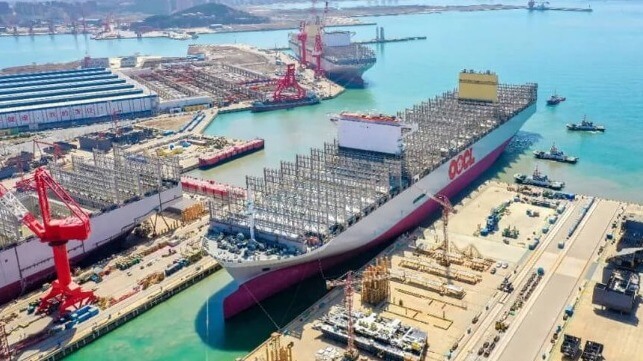Container Shipping on Track for Record Growth Despite Earning Setbacks

The containership sector continues to set new records despite the overall downturn in volumes and rates which is contributing to a near-term dramatic drop in the carriers’ revenues and net income. In its latest analysis, the trade group BIMCO highlights that the industry has already hit a record level of new capacity delivered this year and is on track to increase capacity by more than a quarter by the end of 2025.
“Deliveries of new container ships during the first seven months of the year reached a new record high of 1.2 million TEU in 2023, beating the previous record by 0.2 million TEU,” says Niels Rasmussen, Chief Shipping Analyst at BIMCO. “As recycling of ships has remained low, the fleet capacity has grown 4.3 percent since January.”
The growth companies despite the current dramatic declines in the sector’s earnings. Maersk and CMA CGM previously reported earnings, each presenting a subdued outlook for the market in 2023. Today, Hapag-Lloyd also reported financial results with a 40 percent decline in revenues for the first half of the year and group profit down by two-thirds. CEO Rolf Habben Jansen pointed to a slow recovery while saying that rates on some routes still remain unrealistic.
Hapag is one of the carriers that has begun taking delivery on its new class of ultra large containerships with the second of six vessels with a capacity of 23,664 TEU delivered in South Korea. OOCL and MSC are also continuing to receive their new builds, each with a capacity of over 24,000 TEU while MSC and others are also placing further newbuilding orders.
BIMCO notes, however, that overall the pace of new orders has slowed since the record of 2021, but according to Rasmussen, it is still at twice the pace of the 2010s. So far in 2023, BIMCO calculates that 1.3 million TEU was ordered pushing the total orderbook to 7.6 million TEU as of March and falling back only slightly to now that at 7.2 million TEU after recent deliveries.
Globally the container shipping industry now has over 5,800 dedicated “fully cellular” ships according to calculations from Alphaliner. They set global capacity at over 27 million TEU.
Hapag’s Jansen told investors that despite the current declines in volume the new ships are coming online predicting that capacity will outstrip demand in 2023 and into 2024. He said that slow steaming and some level of scrapping might help to offset some of the capacity growth. However, according to BIMCO, the sector will add a record 2.4 million TEU this year and an even higher 2.9 million TEU in 2024. The pace is currently set to fall back only slightly in 2025 to 1.9 million TEU, signaling three years exceeding the previous high of 1.7 million TEU added in a single year.
“Despite recycling of older ships, the fleet is still expected to grow by approximately 4.5 million TEU between early 2023 and early 2025, increasing the fleet capacity by nearly 18 percent,” says Rasmussen.
BIMCO highlights that while total global container volumes fell 4.3 percent in the first half of 2023, the “all-important head-haul and regional trade lanes” improved in the second quarter of 2023. While overall industry demand is only 3.1 percent higher than in 2019, BIMCO notes the key routes were 5.3 percent ahead of 2019 in the second quarter of 2023.
BIMCO like Hapag points to the growth in the supply side of the sector as the major challenge through 2024. Hapag like many of the major carriers points to continued cost controls as they continue forward with a strategy that will add new capacity to an already over-saturated market.
